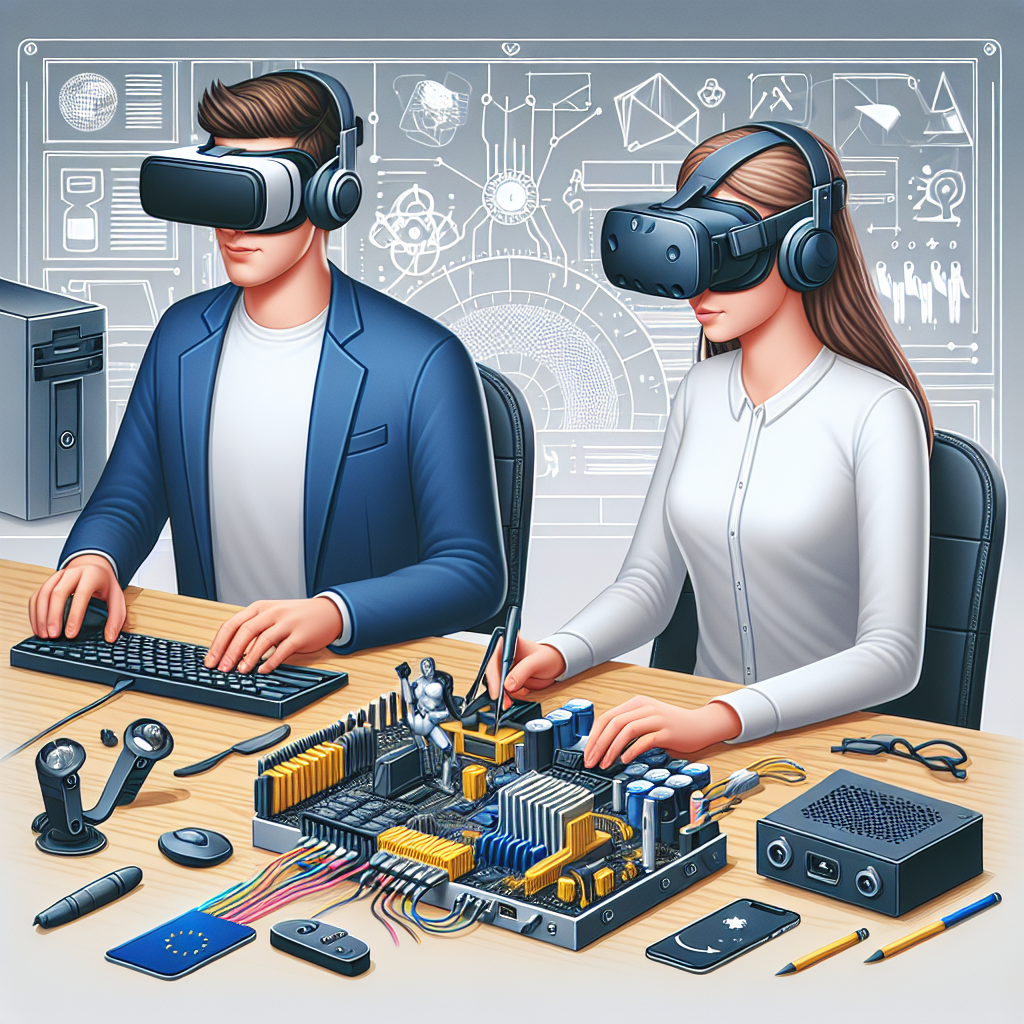Innovative Software Solutions for Virtual Reality Development: Explore How Virtual Reality Technology Works, Discover the Types of Virtual Reality, and Learn About AR vs. VR Differences
What is VR Development and How Does It Transform Industries?

So, what is VR development? At its core, it’s about creating immersive environments that engage users like never before. Think of it as crafting an alternate reality where individuals can interact with digital spaces and objects. This technology is not just for gamers anymore; it’s revolutionizing industries such as education, healthcare, real estate, and training. By providing dynamic experiences, VR development allows businesses to enhance customer engagement and streamline workflows.
Lets look at a short story. Imagine a real estate agent who can show clients virtual walkthroughs of properties, no matter where they are in the world. This means they can explore homes through VR headsets, choosing to view multiple homes without ever stepping outside. This practicality not only saves time but also increases the chance of sales, proving that VR development can genuinely transform industries.
Statistics highlight the impact of VR; studies show that 71% of consumers would shop more often if VR was utilized, and 83% of businesses believe VR improves training experiences. These numbers are hard to ignore! ⭐ Let’s explore how virtual reality technology works and its flourishing applications.
Understanding the Mechanics of Virtual Reality Technology
To grasp how virtual reality technology works, its essential to understand a few key components:
- Head-Mounted Displays (HMDs): These are devices worn on the head that display the virtual environment.
- Motion Tracking: Sensors track your movements, allowing interactions with the VR environment.
- Input Devices: Game controllers or gloves can enhance the sensory experience, translating physical actions into the virtual world.
When all these elements combine, they create a sensory experience that feels incredibly real. This allows users to interact with the environment as if they were actually there. ⭐️
Types of Virtual Reality
What types of virtual reality exist? Here are the main categories:
- Fully Immersive VR: Uses sophisticated HMDs to surround users completely in a virtual environment.
- Non-Immersive VR: Offers a more limited experience, often through a computer screen.
- Augmented Reality (AR): Overlays digital content on the real world, enhancing reality instead of creating a new one.
These variations create numerous possibilities across different fields, impacting everything from gaming ⭐ to therapy and beyond.
What is the Difference Between AR and VR?
It’s common to confuse AR with VR, but understanding their differences is vital. AR enhances the real world with digital elements; think Pokémon GO. In contrast, VR development creates a completely simulated environment that users can engage with. Both technologies have unique applications, but VR development has been a game-changer in training simulations and immersive learning.
Who Develops Virtual Reality?
Given the rapid advancements, understanding who develops virtual reality is crucial. Companies like Facebook (Meta), Google, and dedicated VR startups are at the forefront. However, smaller agencies focused on VR development can provide tailored solutions, often at more competitive prices. At Zuniweb Studio, we specialize in offering custom VR solutions to fit different business needs. ⭐ Connect with us to learn how we can help!
What is Used to Program Virtual Reality?
When it comes to what is used to program virtual reality, developers rely on powerful software platforms. Key tools include:
- Unity: Excellent for creating immersive experiences and widely used in the gaming industry.
- Unreal Engine: Known for its high-quality visuals and physics, perfect for both games and simulations.
- WebVR: Enables VR content directly in web browsers for easy accessibility.
Each tool brings unique features, enhancing the capabilities of VR development. The choice ultimately depends on the project goals.
How Much Does It Cost to Create Virtual Reality?
Curious about how much it costs to create virtual reality? The investment varies depending on complexity. Basic VR applications can start around €8,000, while sophisticated simulations and games may exceed €25,000. Dont let these numbers scare you! Investing in VR development can lead to substantial growth and customer satisfaction in the long run.
At Zuniweb Studio, we understand every business has unique needs and budgets. With over 20 years of experience, our professional specialists guarantee that you get great service without the hassle of contacting multiple vendors. We offer a full spectrum of services, which you can consult for with Alexandr, your dedicated customer relations manager, at Go Telegram Chat.
Real Client Stories: Transforming Through VR
Here’s a story of a client who benefited significantly from our VR development services:
After collaborating with us on a VR training program, a local automotive company reduced training time by 50%. Employees could practice repairs on virtual cars, gaining experience without the risk of damage or injury. This not only saved the company money but also prepared their teams more effectively for real-world challenges.
Would you like to emulate this success? Let’s chat! ⭐
Client Reviews: Quality and Commitment
Don’t just take our word for it. Here’s what some of our clients say:
“Working with Zuniweb Studio was a breath of fresh air! Their knowledge of VR development helped us streamline our processes, and we saw a 30% increase in customer engagement as a result!” This testimonial speaks volumes about the transformations possible with our services. Your story could be next!
In summary, VR development is a game-changer across various industries, reshaping how we interact with technology and each other. Don’t miss out on the opportunity to leverage this powerful tool for your business growth. ⭐
Ready to transform your business with innovative VR solutions? Contact us today at Go Telegram Chat or visit our website at zuniweb.com to learn more! Let’s make your vision a reality!
- ⭐ What is VR development?
- ⭐ How does virtual reality technology work?
- ⭐ What types of virtual reality exist?
- ⭐ What is the difference between AR and VR?
- ⭐ Who develops virtual reality?
- ⭐ What is used to program virtual reality?
- ⭐ How much does it cost to create virtual reality?
Contact us now to harness the power of VR development for your business! ⭐
How Does Virtual Reality Technology Work? Unpacking the Mechanics Behind Immersive Experiences
contact us
Game apps can be really expensive to build and maintain, but don’t worry, we do everything in our mix to ensure that you get the best, for the best cost.

Ever wondered how virtual reality technology works? Let’s take a deep dive into the mechanics behind this fascinating innovation! At its essence, virtual reality operates by creating a simulated environment that users can interact with, allowing for immersive experiences that feel incredibly real. But how do these virtual worlds come to life? ⭐
Key Components of VR Technology
To fully grasp the workings of virtual reality technology, lets break down its core components:
- Head-Mounted Displays (HMDs): These are the most recognizable pieces of VR technology. HMDs are worn like goggles, featuring screens that provide a 360-degree view of the virtual environment. They’re equipped with sensors that track your head movements, allowing you to look around just as you would in the real world.
- Tracking Systems: These systems monitor the users position and movement within the VR space. They can be external (like sensor cameras) or built into the HMD itself, providing precise movement recognition that enhances the immersive experience.
- Input Devices: Tools such as controllers, gloves, or even motion capture suits allow users to interact with the virtual environment. For example, you can pick up virtual objects, manipulate them, or navigate through the virtual world.
- Software: Behind every VR experience is sophisticated software that creates the 3D environment and renders graphics. Platforms like Unity and Unreal Engine are popular choices among developers, enabling complex interactions and stunning visuals.
Creating Immersive Experiences
How do these components work together to create such immersive experiences? Well, let’s say you’re using a VR headset to explore a digital art gallery. The moment you put on the HMD, the screens light up with vivid imagery of the gallery, and as you turn your head, the tracking system ensures that the visuals shift in sync with your movements. With a controller, you can even approach a virtual painting and examine the brushstrokes up close. ⭐
This seamless interaction is what sets virtual reality technology apart. It tricks your brain into feeling as if you’re part of the virtual world, making it a valuable tool across various sectors.
Applications of Virtual Reality Technology
But what about real-world applications? Here are just a few sectors where virtual reality technology is making waves:
- Education: Imagine students exploring ancient civilizations or conducting scientific experiments in a safe virtual space. VR brings learning to life, making it more engaging and memorable.
- Healthcare: Medical professionals can practice complex surgeries in simulated environments, reducing the risk during real procedures and improving their skills.
- Real Estate: Potential buyers can take virtual tours of properties, saving time and enhancing their overall experience.
- Gaming: The gaming industry was one of the first adopters of VR, creating experiences that immerse players in their favorite games like never before. ⭐
The Future of Virtual Reality Technology
The possibilities are endless! As technology continues to advance, we can expect even more revolutionary applications of virtual reality technology. For instance, imagine walking through a virtual store, trying on clothes, or experiencing a concert from the front row without ever leaving your home. ⭐
At Zuniweb Studio, we are committed to leading the way in VR development. Our professional specialists can help businesses leverage this technology to enhance customer experiences and drive engagement. Interested? Let’s chat! Reach out to us at Go Telegram Chat or visit our website at zuniweb.com.
Ready to dive into the world of virtual reality technology? Discover how this innovative field can transform your industry today! ⭐
What Types of Virtual Reality Exist? Exploring Diverse Applications and Innovations in VR
contact us
Game apps can be really expensive to build and maintain, but don’t worry, we do everything in our mix to ensure that you get the best, for the best cost.

When you think of virtual reality, what comes to mind? Is it immersive gaming experiences or those mind-blowing VR simulations? Well, theres a lot more to it! There are several distinct types of virtual reality that cater to various applications and industries. Let’s explore these fascinating categories and how they’re innovating the way we experience the world. ⭐
1. Fully Immersive VR
This is what most people think of when they hear "virtual reality." Fully immersive VR creates a completely digital environment that users can interact with fully. Using sophisticated headsets like Oculus Rift or HTC Vive, users are transported into a different world where they can look around and interact as if they were truly there. It’s commonly used in gaming and training simulations. Imagine a firefighter training in a virtual burning building without any real danger! ⭐
2. Non-Immersive VR
Non-immersive VR offers a more limited experience by resembling standard computer applications or games seen on traditional screens. Users can interact with 3D virtual environments using a mouse or keyboard. This type is popular for applications such as virtual tours, where users can navigate a site without being fully surrounded by VR. Think of it as an interactive video rather than a complete immersion.
3. Augmented Reality (AR)
Often confused with VR, Augmented Reality (AR) enhances the real world by overlaying digital content onto what we see. For example, imagine viewing a historic landmark through your smartphone camera and seeing information about it right on your screen. While it’s not pure VR, AR uses similar technologies to create a blended experience. Games like Pokémon GO brilliantly use AR to bring characters into our everyday lives! ⭐️♂️
4. Mixed Reality (MR)
Mixed Reality (MR) takes AR a step further by allowing real and digital elements to coexist and interact in real-time. MR combines aspects of both VR and AR, creating a hybrid experience. Microsoft’s HoloLens exemplifies this technology, allowing users to interact with both virtual and physical objects. Imagine performing a surgery where both real anatomy and virtual guides coexist to enhance precision! ⭐
5. Collaborative VR
This form of virtual reality enables multiple users to interact within the same virtual space, regardless of their physical locations. It’s a game-changer for remote teams, allowing them to meet and work together in virtual environments. An example is Slack’s integration of VR for virtual meetings, fostering better collaboration and dialogue among team members spread across the globe. ⭐
Applications Across Industries
Now that we’ve unpacked the different types of VR, lets examine how they’re applied across various fields:
- Healthcare: From surgical simulations to patient therapy, VR is transforming how medical professionals train and treat patients.
- Education: Educational institutions use VR for immersive learning experiences, allowing students to visit historical sites or conduct complex science experiments virtually.
- Real Estate: Real estate agents leverage VR for virtual property tours, allowing potential buyers to explore homes without needing to visit in person.
- Entertainment and Gaming: The entertainment sector continues to expand the boundaries of storytelling in gaming and film using VR experiences that captivate and engage users.
Why Choose Zuniweb Studio for Your VR Needs?
At Zuniweb Studio, we’re at the forefront of VR development with over 20 years of experience. Our talented specialists create customized solutions that fit your unique needs, regardless of the industry! We offer a comprehensive spectrum of services, ensuring you have everything you need under one roof. ⭐
Thinking about harnessing the power of virtual reality? Whether you’re in education, healthcare, gaming, or real estate, we’re ready to help you dive into the world of VR! Contact us today at Go Telegram Chat or visit our website at zuniweb.com to start your journey!
What is the Difference Between AR and VR? Debunking Common Myths and Clarifying Concepts
contact us
Game apps can be really expensive to build and maintain, but don’t worry, we do everything in our mix to ensure that you get the best, for the best cost.

The world of immersive technology often brings Augmented Reality (AR) and Virtual Reality (VR) to mind, but many people find themselves confused about the two. Are they the same? How do they differ? In this chapter, we’ll break down the distinctions between AR and VR, debunk some common myths, and clarify these essential concepts. ⭐
Defining AR and VR
To understand the difference between AR and VR, we first need to define each term:
- Augmented Reality (AR): This technology overlays digital information or objects onto the real world. Instead of creating a new environment, AR enhances what’s already there, allowing users to interact with both digital and physical elements simultaneously. Think of mobile apps that can show you the location of nearby stores by overlaying navigation directions onto your real-world view.
- Virtual Reality (VR): In contrast, VR immerses users completely in a digital environment. When someone puts on a VR headset, they are transported to a fully constructed world with its own rules, allowing them to experience settings and scenarios that don’t exist in the real world at all.
Common Use Cases
Now that we have our definitions, let’s look at their applications:
- AR Examples:
- Pokémon GO: This popular mobile game uses AR to place virtual creatures in real-world locations via smartphone cameras. Players can explore their surroundings to catch Pokémon!
- IKEA Place: This app allows users to visualize furniture in their own homes by superimposing 3D models, making it easier to decide what fits best.
- VR Examples:
- Oculus Quest: This VR headset delivers a wide range of immersive games and experiences that transport players into different worlds entirely, from fantasy realms to haunted houses!
- Flight Simulators: Pilots can practice flying under various conditions using VR simulators that replicate real cockpit experiences, enhancing training and skills without any risk. ⭐️
Common Myths Surrounding AR and VR
As fascinating as AR and VR are, misconceptions abound. Let’s clear up a few:
- Myth 1: AR is Just VR Lite: This is a common misconception! AR and VR serve different purposes. AR enhances the real world, while VR creates a completely new one. They can coexist, but they are not interchangeable!
- Myth 2: VR is Only for Gamers: While gaming is a significant part of VR, it’s also used in education, therapy, real estate, and business training. Its applications are vast and versatile!
- Myth 3: AR Requires Special Glasses: Although some forms of AR, like Google Glass, do use glasses, many AR applications work on smartphones and tablets without any additional hardware.
The Future of AR and VR
As technology advances, the potential uses for both AR and VR expand dramatically. From revolutionizing how we shop and learn to enhancing workplace collaboration and training, the future is filled with possibilities! ⭐ Imagine walking into a store where you can see how clothes look on you virtually or attending a meeting in a virtual conference room with colleagues from around the globe.
Why Choose Zuniweb Studio for Your AR and VR Needs?
At Zuniweb Studio, we understand the importance of harnessing these technologies effectively. With over 20 years of experience in VR development, our professional specialists are equipped to deliver tailored solutions for your business, whether you’re interested in AR, VR, or both! We offer comprehensive services all in one place, ensuring seamless implementation of immersive technology.
Ready to transform your business with AR or VR? Contact us today at Go Telegram Chat or visit our website at zuniweb.com to learn more about how we can help you innovate! ⭐

Currently under development

Heroes Infinity: RPG + Strategy + Super Heroes
An epic action RPG packed with heroes, battles, and boundless adventure. Dive into the captivating world of Heroes of Infinity and embark on an unforgettable journey through cities and distant lands. Recruit powerful heroes, battle relentless enemies, and build your ultimate legendary team.
Experience seamless gameplay and captivating challenges. We blend smooth mechanics with dynamic pacing to ensure your adventure never slows down. Dive into an immersive world where every move matters — with rich visuals, responsive controls, and battles that push your strategy and skills.
RPG
mobile
strategy
Unity 3D